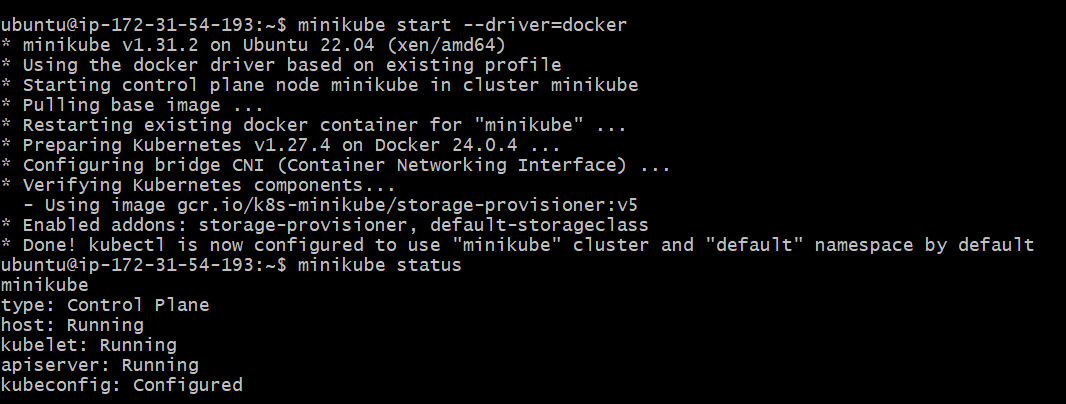Deploying Your First Kubernetes Cluster with Deployment🚀
 Ayushi Vasishtha
Ayushi VasishthaCongratulations on making it to Day 34 of the #90DaysOfDevOps challenge! By now, you've got a good understanding of Kubernetes (often abbreviated as K8s), its architecture, and how to set up a Kubernetes cluster locally using Minikube. Now, let's dive into deploying applications in Kubernetes.
Understanding Kubernetes Deployments🌟
In Kubernetes, Deployment is a powerful resource for managing applications. It provides a declarative way to describe an application's life cycle, including which images to use for the app, the number of replicas, and how to update them over time. Essentially, a Deployment allows you to define your desired application state, and Kubernetes takes care of making it happen.
Here's why Deployments are awesome🔍
Rolling Updates: If you want to release a new version of your app, Deployments allow you to do it smoothly, ensuring there's no downtime. It gradually replaces old replicas with new ones.
Rollbacks: Oops! Did something go wrong with the new version? No worries. You can easily roll back to the previous version with a single command.
Scaling: Need to handle more traffic? Deployments support scaling your application horizontally by adding or removing replicas.
Self-Healing: If a replica fails, Kubernetes will automatically replace it, ensuring your app stays healthy.
Now, let's put this knowledge into practice with a hands-on task.
Task-1: Deploying a Sample Todo-App with Auto-Healing and Auto-Scaling📦
Today's task is all about simplicity but with a significant impact. We will create a Kubernetes Deployment to deploy a sample todo-app. Additionally, we'll set up auto-healing and auto-scaling for the application, two crucial features Kubernetes provides out of the box.
Auto-Healing
Auto-Healing ensures that if a Pod fails or terminates unexpectedly, Kubernetes automatically replaces it to maintain the desired number of replicas. 🏥
Auto-Scaling
Auto-Scaling allows you to automatically adjust the number of replicas based on resource utilization, ensuring that your application can handle increased load without manual intervention. 🚀
Prerequisites:
Verify Minikube's operational status:

If it is stopped, start it by giving the below command:
minikube start --driver=docker

Here are the steps to create your first deployment:
1. Prepare the Deployment YAML:
To create a Deployment, we need to define its desired state in a YAML file.

A sample deployment.yml file is provided below:
apiVersion: apps/v1
kind: Deployment
metadata:
name: todo-app
labels:
app: todo
spec:
replicas: 2
selector:
matchLabels:
app: todo
template:
metadata:
labels:
app: todo
spec:
containers:
- name: todo
image: rishikeshops/todo-app
ports:
- containerPort: 3000
Let's break down each section of the above manifest file:
apiVersion: apps/v1: This line specifies the Kubernetes API version being used. In this case, it's using theapps/v1API version.kind: Deployment: This line defines the Kubernetes resource type being created, which is a Deployment in this case.metadata: This section contains metadata about the Deployment, such as its name and labels. Labels are key-value pairs used to identify and categorize resources.name: todo-app: This is the name assigned to the Deployment resource, which is "todo-app" in this case.labels: Labels are used to tag the Deployment with metadata. In this case, the Deployment is labeled with "app: todo," which can be used for selecting and grouping resources.
spec:The
specsection describes the desired state of the Deployment, including the number of replicas, the selector for identifying pods, and the pod template.replicas: 2: This specifies that the desired number of replicas (instances) of the application is 2. The Deployment will ensure that two identical pods are running at all times.selector: This section specifies how the Deployment identifies the pods it manages.matchLabels: The Deployment selects pods with labels matching the criteria specified here. In this case, it selects pods with the label "app: todo."
template: This section defines the pod template that will be used for creating new pods managed by the Deployment.metadata: This metadata section assigns labels to the pods created from this template. Again, the label "app: todo" is assigned.spec: This spec section describes the pod's specifications, including the containers running inside it.containers: This is an array that can contain multiple containers, but in this case, it contains only one container definition.name: todo: This specifies the name of the container, which is "todo."image: rishikeshops/todo-app: This specifies the Docker image to use for the "todo" container. The image "rishikeshops/todo-app" will be pulled and run in the pod.ports: This section defines the ports that the container exposes.containerPort: 3000: This specifies that the container listens on port 3000.
2. Apply the Deployment:
Once you've customized the deployment.yml file, apply it to your Kubernetes cluster (in this case, Minikube) using the kubectl apply -f deployment.yml command.

3. Verify the deployment status:
kubectl get deployments

That's it! You've just deployed a sample application with auto-healing and auto-scaling features.
By completing this task, you'll not only gain hands-on experience with Kubernetes Deployments but also add another valuable project to your DevOps resume. Keep up the fantastic work, and stay tuned for more DevOps adventures!
Subscribe to my newsletter
Read articles from Ayushi Vasishtha directly inside your inbox. Subscribe to the newsletter, and don't miss out.
Written by

Ayushi Vasishtha
Ayushi Vasishtha
👩💻 Hey there! I'm a DevOps engineer and a tech enthusiast with a passion for sharing knowledge and experiences in the ever-evolving world of software development and infrastructure. As a tech blogger, I love exploring the latest trends and best practices in DevOps, automation, cloud technologies, and continuous integration/delivery. Join me on my blog as I delve into real-world scenarios, offer practical tips, and unravel the complexities of creating seamless software pipelines. Let's build a strong community of tech enthusiasts together and embrace the transformative power of DevOps!